SOE11731 Research Methods: Article Review on Compulsive Buying
VerifiedAdded on 2023/06/13
|6
|2606
|353
Literature Review
AI Summary
This article review examines a research article exploring the factors contributing to compulsive buying behavior, particularly the influence of earlier-in-life events and experiences. The review summarizes the article's key findings, which highlight the role of stress, family disruptions, family communication styles, and socioeconomic status in fostering compulsive purchase tendencies among young adults. The original research, based on a survey of Greek university students, draws from psychological, sociological, and consumer behavior theories to understand the development of this behavior. The review concludes that adolescents who rely heavily on peers and those from lower socioeconomic backgrounds are more likely to exhibit compulsive buying as a coping mechanism, while disruptions in family life can lead to emotionally deprived children who avoid social communication.

Running Head: ARTICLE REVIEW 1
Article Review
Article Review
Paraphrase This Document
Need a fresh take? Get an instant paraphrase of this document with our AI Paraphraser
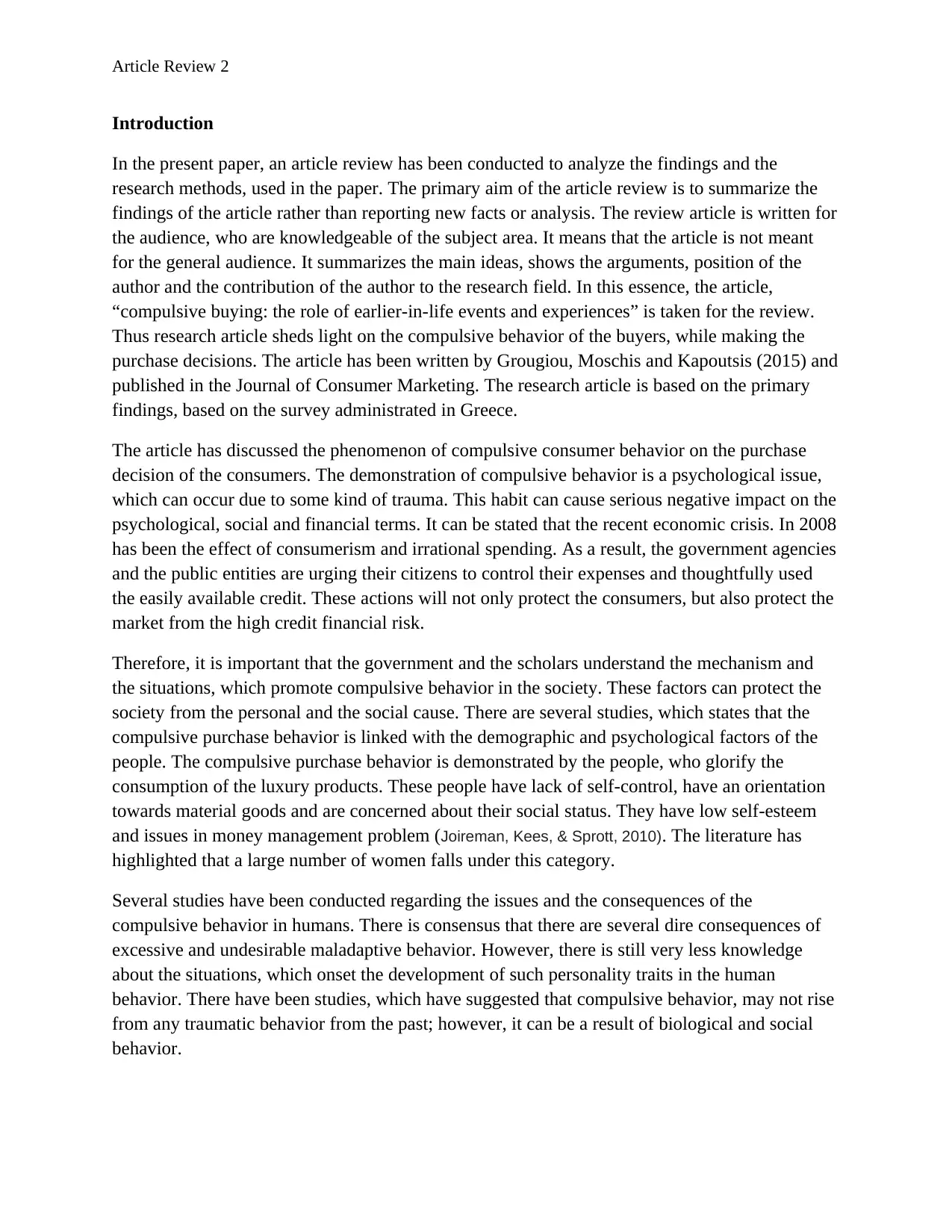
Article Review 2
Introduction
In the present paper, an article review has been conducted to analyze the findings and the
research methods, used in the paper. The primary aim of the article review is to summarize the
findings of the article rather than reporting new facts or analysis. The review article is written for
the audience, who are knowledgeable of the subject area. It means that the article is not meant
for the general audience. It summarizes the main ideas, shows the arguments, position of the
author and the contribution of the author to the research field. In this essence, the article,
“compulsive buying: the role of earlier-in-life events and experiences” is taken for the review.
Thus research article sheds light on the compulsive behavior of the buyers, while making the
purchase decisions. The article has been written by Grougiou, Moschis and Kapoutsis (2015) and
published in the Journal of Consumer Marketing. The research article is based on the primary
findings, based on the survey administrated in Greece.
The article has discussed the phenomenon of compulsive consumer behavior on the purchase
decision of the consumers. The demonstration of compulsive behavior is a psychological issue,
which can occur due to some kind of trauma. This habit can cause serious negative impact on the
psychological, social and financial terms. It can be stated that the recent economic crisis. In 2008
has been the effect of consumerism and irrational spending. As a result, the government agencies
and the public entities are urging their citizens to control their expenses and thoughtfully used
the easily available credit. These actions will not only protect the consumers, but also protect the
market from the high credit financial risk.
Therefore, it is important that the government and the scholars understand the mechanism and
the situations, which promote compulsive behavior in the society. These factors can protect the
society from the personal and the social cause. There are several studies, which states that the
compulsive purchase behavior is linked with the demographic and psychological factors of the
people. The compulsive purchase behavior is demonstrated by the people, who glorify the
consumption of the luxury products. These people have lack of self-control, have an orientation
towards material goods and are concerned about their social status. They have low self-esteem
and issues in money management problem (Joireman, Kees, & Sprott, 2010). The literature has
highlighted that a large number of women falls under this category.
Several studies have been conducted regarding the issues and the consequences of the
compulsive behavior in humans. There is consensus that there are several dire consequences of
excessive and undesirable maladaptive behavior. However, there is still very less knowledge
about the situations, which onset the development of such personality traits in the human
behavior. There have been studies, which have suggested that compulsive behavior, may not rise
from any traumatic behavior from the past; however, it can be a result of biological and social
behavior.
Introduction
In the present paper, an article review has been conducted to analyze the findings and the
research methods, used in the paper. The primary aim of the article review is to summarize the
findings of the article rather than reporting new facts or analysis. The review article is written for
the audience, who are knowledgeable of the subject area. It means that the article is not meant
for the general audience. It summarizes the main ideas, shows the arguments, position of the
author and the contribution of the author to the research field. In this essence, the article,
“compulsive buying: the role of earlier-in-life events and experiences” is taken for the review.
Thus research article sheds light on the compulsive behavior of the buyers, while making the
purchase decisions. The article has been written by Grougiou, Moschis and Kapoutsis (2015) and
published in the Journal of Consumer Marketing. The research article is based on the primary
findings, based on the survey administrated in Greece.
The article has discussed the phenomenon of compulsive consumer behavior on the purchase
decision of the consumers. The demonstration of compulsive behavior is a psychological issue,
which can occur due to some kind of trauma. This habit can cause serious negative impact on the
psychological, social and financial terms. It can be stated that the recent economic crisis. In 2008
has been the effect of consumerism and irrational spending. As a result, the government agencies
and the public entities are urging their citizens to control their expenses and thoughtfully used
the easily available credit. These actions will not only protect the consumers, but also protect the
market from the high credit financial risk.
Therefore, it is important that the government and the scholars understand the mechanism and
the situations, which promote compulsive behavior in the society. These factors can protect the
society from the personal and the social cause. There are several studies, which states that the
compulsive purchase behavior is linked with the demographic and psychological factors of the
people. The compulsive purchase behavior is demonstrated by the people, who glorify the
consumption of the luxury products. These people have lack of self-control, have an orientation
towards material goods and are concerned about their social status. They have low self-esteem
and issues in money management problem (Joireman, Kees, & Sprott, 2010). The literature has
highlighted that a large number of women falls under this category.
Several studies have been conducted regarding the issues and the consequences of the
compulsive behavior in humans. There is consensus that there are several dire consequences of
excessive and undesirable maladaptive behavior. However, there is still very less knowledge
about the situations, which onset the development of such personality traits in the human
behavior. There have been studies, which have suggested that compulsive behavior, may not rise
from any traumatic behavior from the past; however, it can be a result of biological and social
behavior.
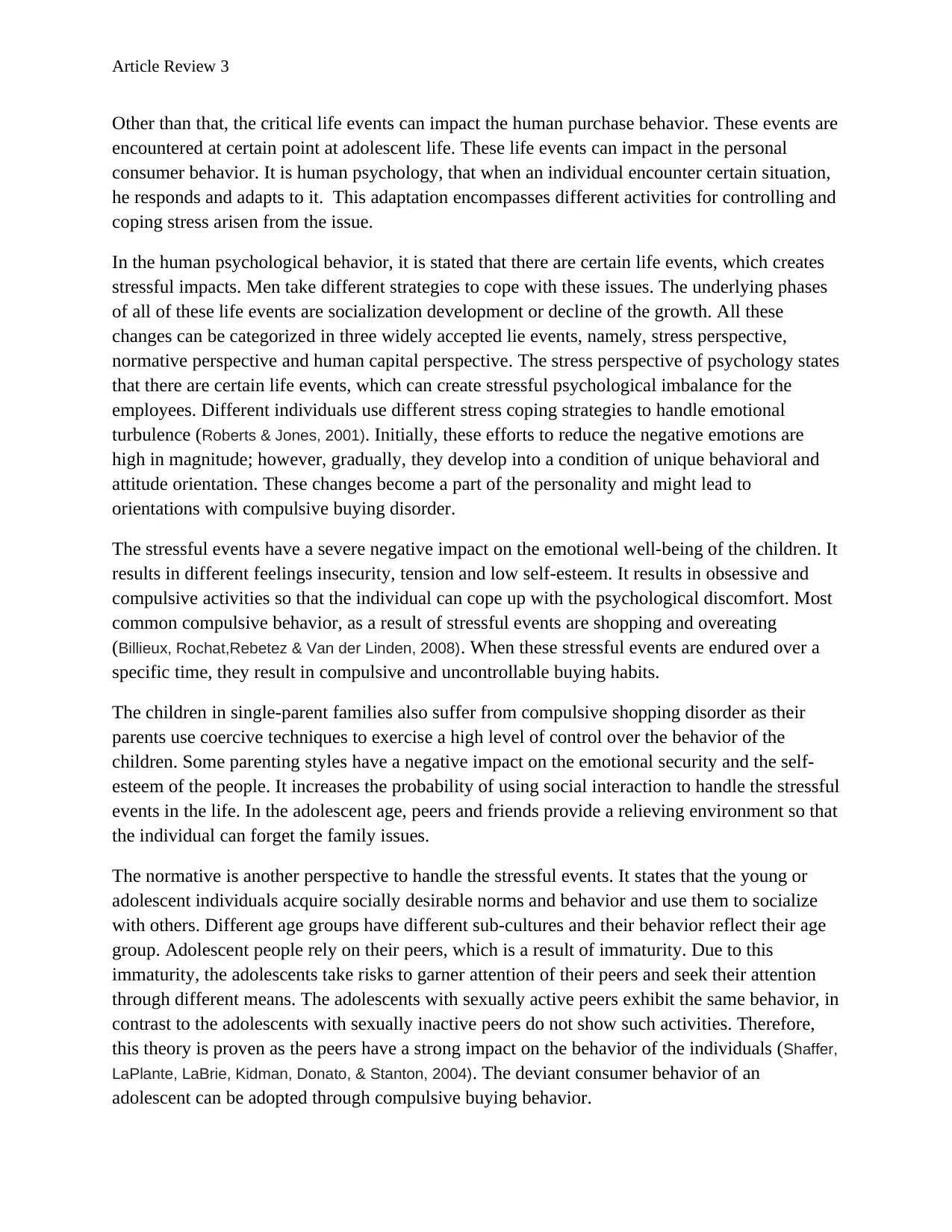
Article Review 3
Other than that, the critical life events can impact the human purchase behavior. These events are
encountered at certain point at adolescent life. These life events can impact in the personal
consumer behavior. It is human psychology, that when an individual encounter certain situation,
he responds and adapts to it. This adaptation encompasses different activities for controlling and
coping stress arisen from the issue.
In the human psychological behavior, it is stated that there are certain life events, which creates
stressful impacts. Men take different strategies to cope with these issues. The underlying phases
of all of these life events are socialization development or decline of the growth. All these
changes can be categorized in three widely accepted lie events, namely, stress perspective,
normative perspective and human capital perspective. The stress perspective of psychology states
that there are certain life events, which can create stressful psychological imbalance for the
employees. Different individuals use different stress coping strategies to handle emotional
turbulence (Roberts & Jones, 2001). Initially, these efforts to reduce the negative emotions are
high in magnitude; however, gradually, they develop into a condition of unique behavioral and
attitude orientation. These changes become a part of the personality and might lead to
orientations with compulsive buying disorder.
The stressful events have a severe negative impact on the emotional well-being of the children. It
results in different feelings insecurity, tension and low self-esteem. It results in obsessive and
compulsive activities so that the individual can cope up with the psychological discomfort. Most
common compulsive behavior, as a result of stressful events are shopping and overeating
(Billieux, Rochat,Rebetez & Van der Linden, 2008). When these stressful events are endured over a
specific time, they result in compulsive and uncontrollable buying habits.
The children in single-parent families also suffer from compulsive shopping disorder as their
parents use coercive techniques to exercise a high level of control over the behavior of the
children. Some parenting styles have a negative impact on the emotional security and the self-
esteem of the people. It increases the probability of using social interaction to handle the stressful
events in the life. In the adolescent age, peers and friends provide a relieving environment so that
the individual can forget the family issues.
The normative is another perspective to handle the stressful events. It states that the young or
adolescent individuals acquire socially desirable norms and behavior and use them to socialize
with others. Different age groups have different sub-cultures and their behavior reflect their age
group. Adolescent people rely on their peers, which is a result of immaturity. Due to this
immaturity, the adolescents take risks to garner attention of their peers and seek their attention
through different means. The adolescents with sexually active peers exhibit the same behavior, in
contrast to the adolescents with sexually inactive peers do not show such activities. Therefore,
this theory is proven as the peers have a strong impact on the behavior of the individuals (Shaffer,
LaPlante, LaBrie, Kidman, Donato, & Stanton, 2004). The deviant consumer behavior of an
adolescent can be adopted through compulsive buying behavior.
Other than that, the critical life events can impact the human purchase behavior. These events are
encountered at certain point at adolescent life. These life events can impact in the personal
consumer behavior. It is human psychology, that when an individual encounter certain situation,
he responds and adapts to it. This adaptation encompasses different activities for controlling and
coping stress arisen from the issue.
In the human psychological behavior, it is stated that there are certain life events, which creates
stressful impacts. Men take different strategies to cope with these issues. The underlying phases
of all of these life events are socialization development or decline of the growth. All these
changes can be categorized in three widely accepted lie events, namely, stress perspective,
normative perspective and human capital perspective. The stress perspective of psychology states
that there are certain life events, which can create stressful psychological imbalance for the
employees. Different individuals use different stress coping strategies to handle emotional
turbulence (Roberts & Jones, 2001). Initially, these efforts to reduce the negative emotions are
high in magnitude; however, gradually, they develop into a condition of unique behavioral and
attitude orientation. These changes become a part of the personality and might lead to
orientations with compulsive buying disorder.
The stressful events have a severe negative impact on the emotional well-being of the children. It
results in different feelings insecurity, tension and low self-esteem. It results in obsessive and
compulsive activities so that the individual can cope up with the psychological discomfort. Most
common compulsive behavior, as a result of stressful events are shopping and overeating
(Billieux, Rochat,Rebetez & Van der Linden, 2008). When these stressful events are endured over a
specific time, they result in compulsive and uncontrollable buying habits.
The children in single-parent families also suffer from compulsive shopping disorder as their
parents use coercive techniques to exercise a high level of control over the behavior of the
children. Some parenting styles have a negative impact on the emotional security and the self-
esteem of the people. It increases the probability of using social interaction to handle the stressful
events in the life. In the adolescent age, peers and friends provide a relieving environment so that
the individual can forget the family issues.
The normative is another perspective to handle the stressful events. It states that the young or
adolescent individuals acquire socially desirable norms and behavior and use them to socialize
with others. Different age groups have different sub-cultures and their behavior reflect their age
group. Adolescent people rely on their peers, which is a result of immaturity. Due to this
immaturity, the adolescents take risks to garner attention of their peers and seek their attention
through different means. The adolescents with sexually active peers exhibit the same behavior, in
contrast to the adolescents with sexually inactive peers do not show such activities. Therefore,
this theory is proven as the peers have a strong impact on the behavior of the individuals (Shaffer,
LaPlante, LaBrie, Kidman, Donato, & Stanton, 2004). The deviant consumer behavior of an
adolescent can be adopted through compulsive buying behavior.
⊘ This is a preview!⊘
Do you want full access?
Subscribe today to unlock all pages.

Trusted by 1+ million students worldwide
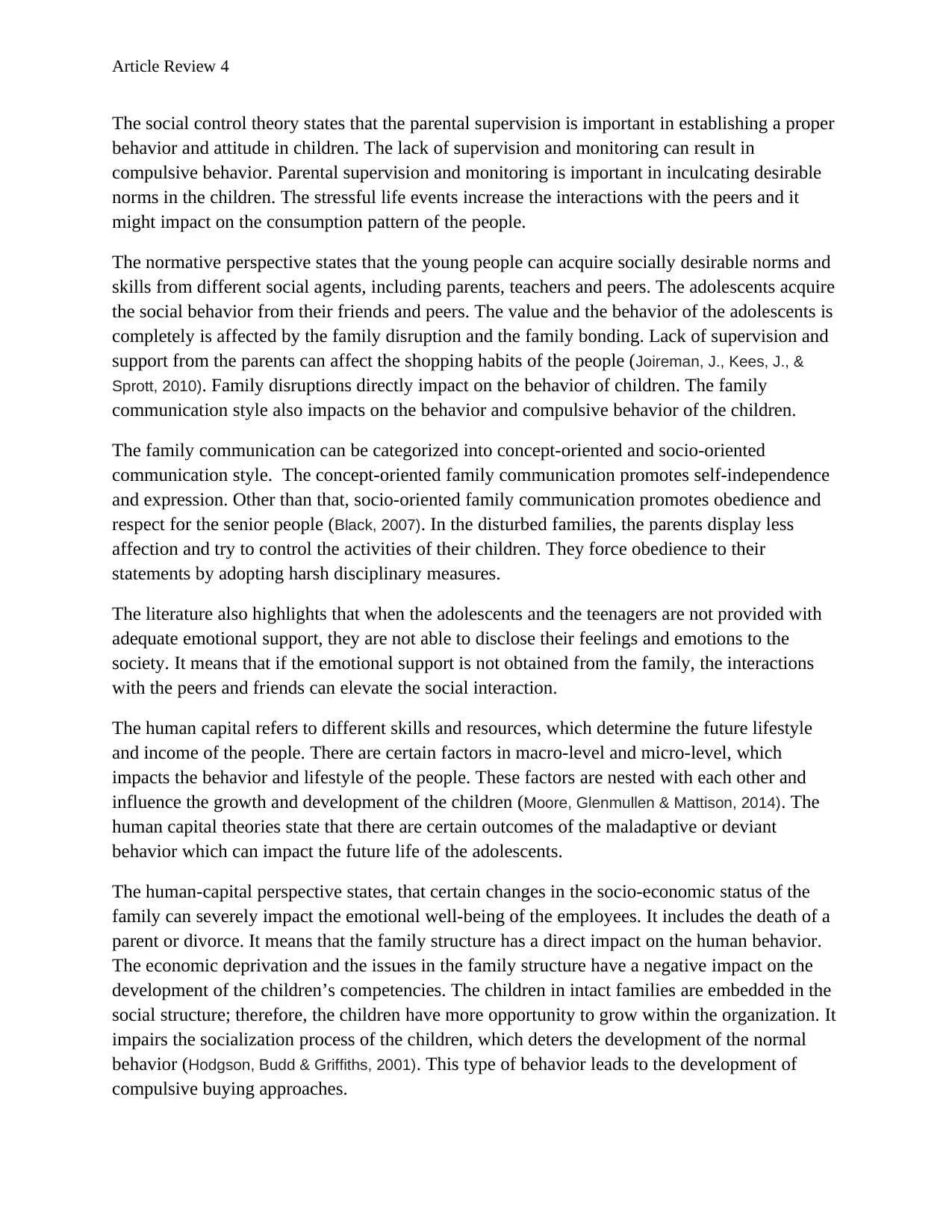
Article Review 4
The social control theory states that the parental supervision is important in establishing a proper
behavior and attitude in children. The lack of supervision and monitoring can result in
compulsive behavior. Parental supervision and monitoring is important in inculcating desirable
norms in the children. The stressful life events increase the interactions with the peers and it
might impact on the consumption pattern of the people.
The normative perspective states that the young people can acquire socially desirable norms and
skills from different social agents, including parents, teachers and peers. The adolescents acquire
the social behavior from their friends and peers. The value and the behavior of the adolescents is
completely is affected by the family disruption and the family bonding. Lack of supervision and
support from the parents can affect the shopping habits of the people (Joireman, J., Kees, J., &
Sprott, 2010). Family disruptions directly impact on the behavior of children. The family
communication style also impacts on the behavior and compulsive behavior of the children.
The family communication can be categorized into concept-oriented and socio-oriented
communication style. The concept-oriented family communication promotes self-independence
and expression. Other than that, socio-oriented family communication promotes obedience and
respect for the senior people (Black, 2007). In the disturbed families, the parents display less
affection and try to control the activities of their children. They force obedience to their
statements by adopting harsh disciplinary measures.
The literature also highlights that when the adolescents and the teenagers are not provided with
adequate emotional support, they are not able to disclose their feelings and emotions to the
society. It means that if the emotional support is not obtained from the family, the interactions
with the peers and friends can elevate the social interaction.
The human capital refers to different skills and resources, which determine the future lifestyle
and income of the people. There are certain factors in macro-level and micro-level, which
impacts the behavior and lifestyle of the people. These factors are nested with each other and
influence the growth and development of the children (Moore, Glenmullen & Mattison, 2014). The
human capital theories state that there are certain outcomes of the maladaptive or deviant
behavior which can impact the future life of the adolescents.
The human-capital perspective states, that certain changes in the socio-economic status of the
family can severely impact the emotional well-being of the employees. It includes the death of a
parent or divorce. It means that the family structure has a direct impact on the human behavior.
The economic deprivation and the issues in the family structure have a negative impact on the
development of the children’s competencies. The children in intact families are embedded in the
social structure; therefore, the children have more opportunity to grow within the organization. It
impairs the socialization process of the children, which deters the development of the normal
behavior (Hodgson, Budd & Griffiths, 2001). This type of behavior leads to the development of
compulsive buying approaches.
The social control theory states that the parental supervision is important in establishing a proper
behavior and attitude in children. The lack of supervision and monitoring can result in
compulsive behavior. Parental supervision and monitoring is important in inculcating desirable
norms in the children. The stressful life events increase the interactions with the peers and it
might impact on the consumption pattern of the people.
The normative perspective states that the young people can acquire socially desirable norms and
skills from different social agents, including parents, teachers and peers. The adolescents acquire
the social behavior from their friends and peers. The value and the behavior of the adolescents is
completely is affected by the family disruption and the family bonding. Lack of supervision and
support from the parents can affect the shopping habits of the people (Joireman, J., Kees, J., &
Sprott, 2010). Family disruptions directly impact on the behavior of children. The family
communication style also impacts on the behavior and compulsive behavior of the children.
The family communication can be categorized into concept-oriented and socio-oriented
communication style. The concept-oriented family communication promotes self-independence
and expression. Other than that, socio-oriented family communication promotes obedience and
respect for the senior people (Black, 2007). In the disturbed families, the parents display less
affection and try to control the activities of their children. They force obedience to their
statements by adopting harsh disciplinary measures.
The literature also highlights that when the adolescents and the teenagers are not provided with
adequate emotional support, they are not able to disclose their feelings and emotions to the
society. It means that if the emotional support is not obtained from the family, the interactions
with the peers and friends can elevate the social interaction.
The human capital refers to different skills and resources, which determine the future lifestyle
and income of the people. There are certain factors in macro-level and micro-level, which
impacts the behavior and lifestyle of the people. These factors are nested with each other and
influence the growth and development of the children (Moore, Glenmullen & Mattison, 2014). The
human capital theories state that there are certain outcomes of the maladaptive or deviant
behavior which can impact the future life of the adolescents.
The human-capital perspective states, that certain changes in the socio-economic status of the
family can severely impact the emotional well-being of the employees. It includes the death of a
parent or divorce. It means that the family structure has a direct impact on the human behavior.
The economic deprivation and the issues in the family structure have a negative impact on the
development of the children’s competencies. The children in intact families are embedded in the
social structure; therefore, the children have more opportunity to grow within the organization. It
impairs the socialization process of the children, which deters the development of the normal
behavior (Hodgson, Budd & Griffiths, 2001). This type of behavior leads to the development of
compulsive buying approaches.
Paraphrase This Document
Need a fresh take? Get an instant paraphrase of this document with our AI Paraphraser
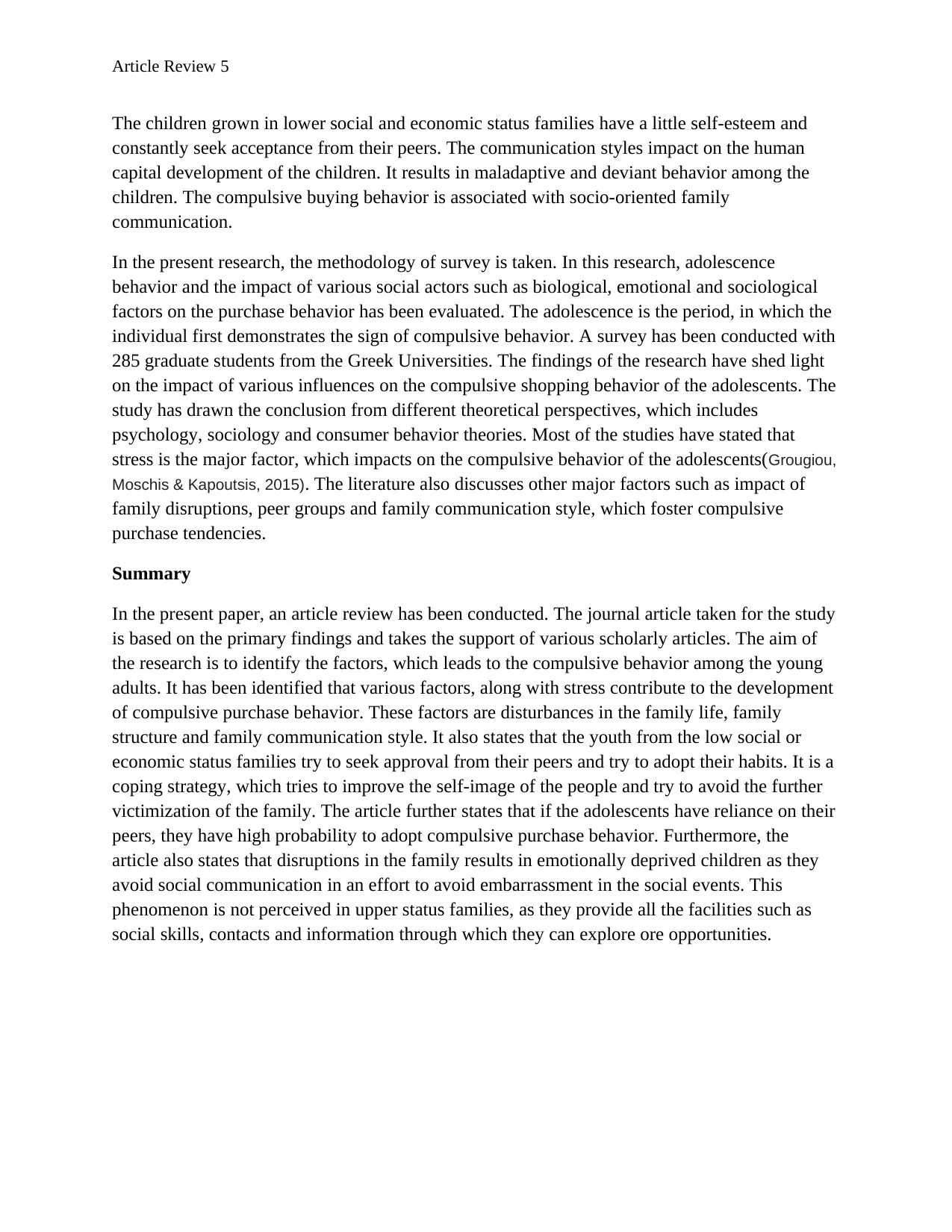
Article Review 5
The children grown in lower social and economic status families have a little self-esteem and
constantly seek acceptance from their peers. The communication styles impact on the human
capital development of the children. It results in maladaptive and deviant behavior among the
children. The compulsive buying behavior is associated with socio-oriented family
communication.
In the present research, the methodology of survey is taken. In this research, adolescence
behavior and the impact of various social actors such as biological, emotional and sociological
factors on the purchase behavior has been evaluated. The adolescence is the period, in which the
individual first demonstrates the sign of compulsive behavior. A survey has been conducted with
285 graduate students from the Greek Universities. The findings of the research have shed light
on the impact of various influences on the compulsive shopping behavior of the adolescents. The
study has drawn the conclusion from different theoretical perspectives, which includes
psychology, sociology and consumer behavior theories. Most of the studies have stated that
stress is the major factor, which impacts on the compulsive behavior of the adolescents(Grougiou,
Moschis & Kapoutsis, 2015). The literature also discusses other major factors such as impact of
family disruptions, peer groups and family communication style, which foster compulsive
purchase tendencies.
Summary
In the present paper, an article review has been conducted. The journal article taken for the study
is based on the primary findings and takes the support of various scholarly articles. The aim of
the research is to identify the factors, which leads to the compulsive behavior among the young
adults. It has been identified that various factors, along with stress contribute to the development
of compulsive purchase behavior. These factors are disturbances in the family life, family
structure and family communication style. It also states that the youth from the low social or
economic status families try to seek approval from their peers and try to adopt their habits. It is a
coping strategy, which tries to improve the self-image of the people and try to avoid the further
victimization of the family. The article further states that if the adolescents have reliance on their
peers, they have high probability to adopt compulsive purchase behavior. Furthermore, the
article also states that disruptions in the family results in emotionally deprived children as they
avoid social communication in an effort to avoid embarrassment in the social events. This
phenomenon is not perceived in upper status families, as they provide all the facilities such as
social skills, contacts and information through which they can explore ore opportunities.
The children grown in lower social and economic status families have a little self-esteem and
constantly seek acceptance from their peers. The communication styles impact on the human
capital development of the children. It results in maladaptive and deviant behavior among the
children. The compulsive buying behavior is associated with socio-oriented family
communication.
In the present research, the methodology of survey is taken. In this research, adolescence
behavior and the impact of various social actors such as biological, emotional and sociological
factors on the purchase behavior has been evaluated. The adolescence is the period, in which the
individual first demonstrates the sign of compulsive behavior. A survey has been conducted with
285 graduate students from the Greek Universities. The findings of the research have shed light
on the impact of various influences on the compulsive shopping behavior of the adolescents. The
study has drawn the conclusion from different theoretical perspectives, which includes
psychology, sociology and consumer behavior theories. Most of the studies have stated that
stress is the major factor, which impacts on the compulsive behavior of the adolescents(Grougiou,
Moschis & Kapoutsis, 2015). The literature also discusses other major factors such as impact of
family disruptions, peer groups and family communication style, which foster compulsive
purchase tendencies.
Summary
In the present paper, an article review has been conducted. The journal article taken for the study
is based on the primary findings and takes the support of various scholarly articles. The aim of
the research is to identify the factors, which leads to the compulsive behavior among the young
adults. It has been identified that various factors, along with stress contribute to the development
of compulsive purchase behavior. These factors are disturbances in the family life, family
structure and family communication style. It also states that the youth from the low social or
economic status families try to seek approval from their peers and try to adopt their habits. It is a
coping strategy, which tries to improve the self-image of the people and try to avoid the further
victimization of the family. The article further states that if the adolescents have reliance on their
peers, they have high probability to adopt compulsive purchase behavior. Furthermore, the
article also states that disruptions in the family results in emotionally deprived children as they
avoid social communication in an effort to avoid embarrassment in the social events. This
phenomenon is not perceived in upper status families, as they provide all the facilities such as
social skills, contacts and information through which they can explore ore opportunities.
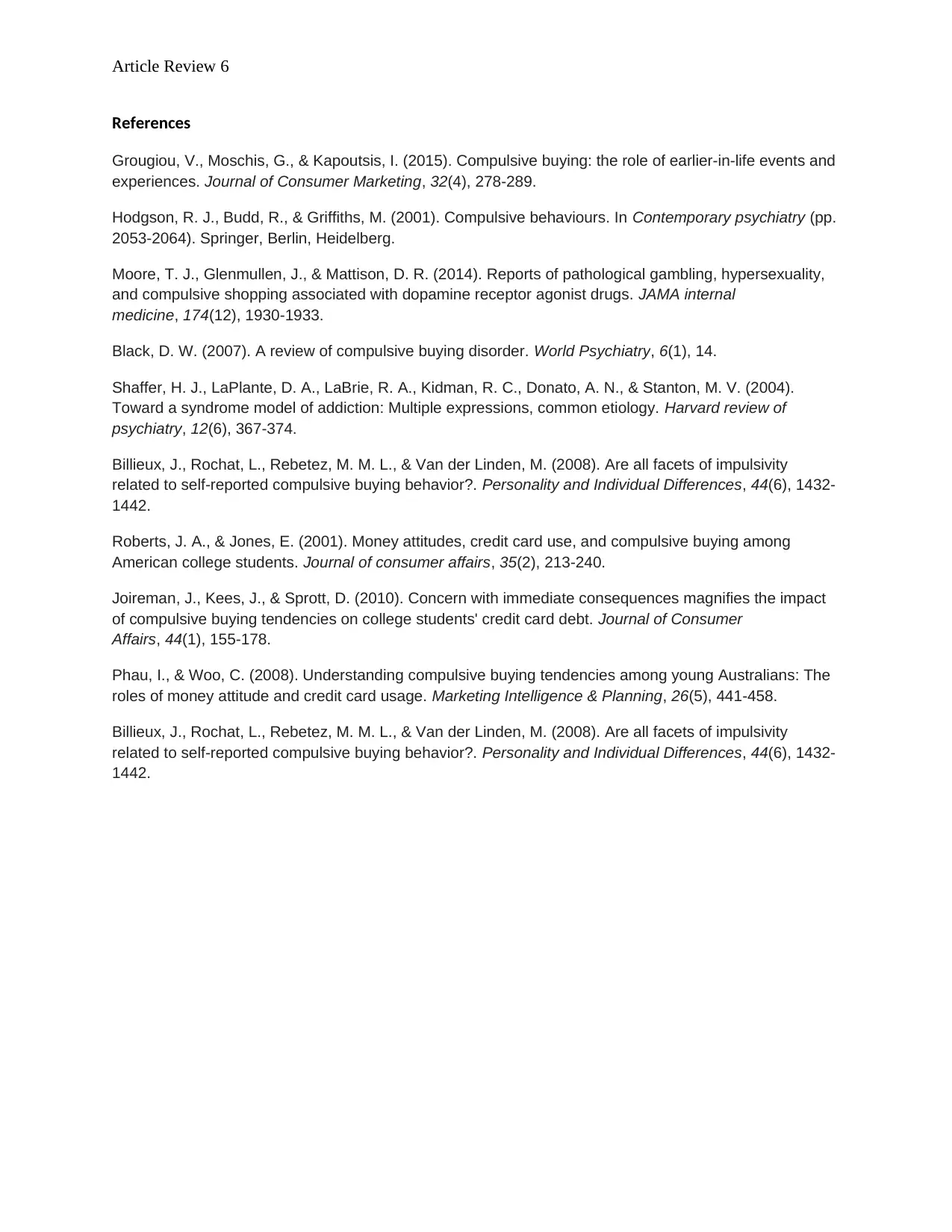
Article Review 6
References
Grougiou, V., Moschis, G., & Kapoutsis, I. (2015). Compulsive buying: the role of earlier-in-life events and
experiences. Journal of Consumer Marketing, 32(4), 278-289.
Hodgson, R. J., Budd, R., & Griffiths, M. (2001). Compulsive behaviours. In Contemporary psychiatry (pp.
2053-2064). Springer, Berlin, Heidelberg.
Moore, T. J., Glenmullen, J., & Mattison, D. R. (2014). Reports of pathological gambling, hypersexuality,
and compulsive shopping associated with dopamine receptor agonist drugs. JAMA internal
medicine, 174(12), 1930-1933.
Black, D. W. (2007). A review of compulsive buying disorder. World Psychiatry, 6(1), 14.
Shaffer, H. J., LaPlante, D. A., LaBrie, R. A., Kidman, R. C., Donato, A. N., & Stanton, M. V. (2004).
Toward a syndrome model of addiction: Multiple expressions, common etiology. Harvard review of
psychiatry, 12(6), 367-374.
Billieux, J., Rochat, L., Rebetez, M. M. L., & Van der Linden, M. (2008). Are all facets of impulsivity
related to self-reported compulsive buying behavior?. Personality and Individual Differences, 44(6), 1432-
1442.
Roberts, J. A., & Jones, E. (2001). Money attitudes, credit card use, and compulsive buying among
American college students. Journal of consumer affairs, 35(2), 213-240.
Joireman, J., Kees, J., & Sprott, D. (2010). Concern with immediate consequences magnifies the impact
of compulsive buying tendencies on college students' credit card debt. Journal of Consumer
Affairs, 44(1), 155-178.
Phau, I., & Woo, C. (2008). Understanding compulsive buying tendencies among young Australians: The
roles of money attitude and credit card usage. Marketing Intelligence & Planning, 26(5), 441-458.
Billieux, J., Rochat, L., Rebetez, M. M. L., & Van der Linden, M. (2008). Are all facets of impulsivity
related to self-reported compulsive buying behavior?. Personality and Individual Differences, 44(6), 1432-
1442.
References
Grougiou, V., Moschis, G., & Kapoutsis, I. (2015). Compulsive buying: the role of earlier-in-life events and
experiences. Journal of Consumer Marketing, 32(4), 278-289.
Hodgson, R. J., Budd, R., & Griffiths, M. (2001). Compulsive behaviours. In Contemporary psychiatry (pp.
2053-2064). Springer, Berlin, Heidelberg.
Moore, T. J., Glenmullen, J., & Mattison, D. R. (2014). Reports of pathological gambling, hypersexuality,
and compulsive shopping associated with dopamine receptor agonist drugs. JAMA internal
medicine, 174(12), 1930-1933.
Black, D. W. (2007). A review of compulsive buying disorder. World Psychiatry, 6(1), 14.
Shaffer, H. J., LaPlante, D. A., LaBrie, R. A., Kidman, R. C., Donato, A. N., & Stanton, M. V. (2004).
Toward a syndrome model of addiction: Multiple expressions, common etiology. Harvard review of
psychiatry, 12(6), 367-374.
Billieux, J., Rochat, L., Rebetez, M. M. L., & Van der Linden, M. (2008). Are all facets of impulsivity
related to self-reported compulsive buying behavior?. Personality and Individual Differences, 44(6), 1432-
1442.
Roberts, J. A., & Jones, E. (2001). Money attitudes, credit card use, and compulsive buying among
American college students. Journal of consumer affairs, 35(2), 213-240.
Joireman, J., Kees, J., & Sprott, D. (2010). Concern with immediate consequences magnifies the impact
of compulsive buying tendencies on college students' credit card debt. Journal of Consumer
Affairs, 44(1), 155-178.
Phau, I., & Woo, C. (2008). Understanding compulsive buying tendencies among young Australians: The
roles of money attitude and credit card usage. Marketing Intelligence & Planning, 26(5), 441-458.
Billieux, J., Rochat, L., Rebetez, M. M. L., & Van der Linden, M. (2008). Are all facets of impulsivity
related to self-reported compulsive buying behavior?. Personality and Individual Differences, 44(6), 1432-
1442.
⊘ This is a preview!⊘
Do you want full access?
Subscribe today to unlock all pages.

Trusted by 1+ million students worldwide
1 out of 6
Related Documents
Your All-in-One AI-Powered Toolkit for Academic Success.
+13062052269
info@desklib.com
Available 24*7 on WhatsApp / Email
![[object Object]](/_next/static/media/star-bottom.7253800d.svg)
Unlock your academic potential
Copyright © 2020–2025 A2Z Services. All Rights Reserved. Developed and managed by ZUCOL.





